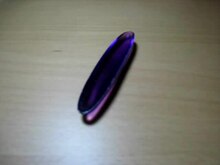Celtic rocking stone
A Celtic rocking stone (also Celtic rocking wood , Celt or rattleback ) is a physical toy . It consists of a ten to twenty centimeter long piece of stone, wood, plastic or other material with an ellipsoidal shape on the underside .
properties
If you turn a rocking stone lying on its rounded side on a flat surface, it behaves differently depending on the direction of rotation: In one direction of rotation (for example clockwise) the rocking stone rotates stably, as expected, until it comes to a stop due to friction . This direction of rotation is also called the preferred direction of rotation of the rocking stone. In the other direction of rotation, however, the rocking stone quickly slows down, where it begins to wobble along the longitudinal axis. After the rotation has completely changed into a wobbling oscillation, the wobbling stone begins to rotate in the opposite direction to the original direction of rotation.
Naming
The name Celtic rocking stone comes from the fact that allegedly Celtic priests used the stones to make decisions or to influence the decisions of others.
Cause of behavior
The cause of the movement is not very clear. The mass of a rocking stone is asymmetrically distributed, which is achieved through natural conditions or embedded or seated weights. The resulting imbalance and the friction with the base cause the wobbling movement. During each oscillation, the rocking stone tilts slightly in the direction of its excess weight, so that it rotates in its preferred direction.
There are extensive physical studies of the rocking stone.
Chirality
A flat surface and the force of gravity acting perpendicularly on it are rotationally symmetrical. The existence of a preferred direction of rotation of the wobbly body must therefore be deducible from the properties of this body itself. If the rocking stone is a flat, two-axially parallel section of an elongated or ellipsoid , then mirror symmetry applies in the longitudinal and transverse directions. But the additional centrifugal masses on the rocking stone (in the picture the turtles) sit, similar to the paddlers in a two-man canoe , diagonally, namely to the right and left a little to the side of the boat's longitudinal axis.
The axis of the lowest moment of inertia therefore deviates from the longitudinal axis of the boat shape in the direction of the line connecting these additional masses. The longitudinal axis of the ellipsoid is higher - otherwise the boat would tip over; it spans a helix with the axis of the lowest moment of inertia . The two axes are relevant to movement due to tilting vibrations and contact forces. They are in a clearly chiral position to one another, because the projection of one crosses the other at an angle deviating from 90 °. This chirality makes chiral behavior of the rocking stone plausible.
Web links
- Video about rocking stones image of science ( RAM ; 0 kB)
- More information about the Wackelstein www.wundersamessammelsurium.info

